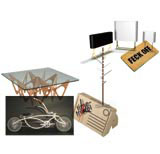Joint effort
Trish Lorenz talks to members of Shift, a multidisciplinary group of 12 designers who use their collective skills to creative effect

Creative endeavours – from art to photography and design – are notoriously individualistic. The desire to protect an idea, gain creative credit or simply control output, means true collaboration, as opposed to delegation, is rare.
But collaboration can offer real benefits, as evidenced by the members of Shift, a collective of up-and-coming young designers with a co-operative approach to working.
The group has this month been appointed to create concepts for a learning zone at Sir Norman Foster’s latest project, a ground-breaking school in west London due to open in September. Shift will design furniture and interiors for the zone and see the project through to fit-out.
This follows the launch of Sunday last month, which saw two members of the collective, Sam Johnson and Morph, plus manufacturer Blueline, reveal a furniture range, including a sideboard, trestle, coat stand and coffee table.
Johnson says the collaborative approach has been an eye-opener for all the designers in the group. ‘When you work as part of a group the speed at which you develop an idea is amazing,’ he explains. ‘You’re able to move on more quickly when you encounter problems and you learn more too. I’ve learnt so much about environment-friendly materials, for example, things that I’m applying in my other work.’
Johnson has continued to embrace a collaborative way of working, and is now working on separate ventures with Shift members Richard Shed and Chris Jackson.
Jackson is also enthusiastic about the benefits of collaboration and is working on a number of joint projects. He’s recently teamed up with Paul Stafford, a graphic designer, to create the Post It clock.
‘It’s refreshing to work with people who bring something different to the table,’ Jackson says. ‘It’s easy to get caught up when you work on your own and it’s more difficult to see the wider view or acknowledge problems.’
Arash Kaynama and Kelly Sant of Shift collaborate with a number of designers and artists. And they have stretched the concept of co-operation even further by working with two polymer scientists at Imperial College in London.
The project has inspired a number of ideas, including a footwear range modelled on the way blood vessels work.
‘Scientists are exciting and intelligent people to work with,’ says Sant, though she acknowledges that it’s important to ‘learn their language or find a mediator’.
Of course, true collaboration – as opposed to delegation – requires certain qualities. Jackson suggests respect and humility are key.
‘Humility is a very important aspect of working together. If the better idea comes from the other person you have to be able to recognise that, and also have the confidence to realise that what comes out is jointly owned,’ he says.
Joint creative development doesn’t mean debating every pen stroke or sharing every moment of the working day. Shed and Johnson share a desk space, but are rarely in the office at the same time.
They work by drawing in different coloured ink on the same page. Johnson points to drawings for a chair design, with Shed’s marks in blue and his own in red. ‘Ideas move in different directions,’ explains Johnson. ‘We see things differently and respond differently and bounce ideas off each other.’
There’s recognition that individual work and identity need not be lost by collaboration. Member Peter MacCann says, ‘It’s good to work with other people, but you need to develop your style and the confidence to do your own thing.’
Shift shows that effective collaboration delivers the opportunity to produce more work, broaden thinking, learn from other disciplines and ultimately grow as a designer. And it needn’t suggest a creative deficiency. As Johnson says, ‘The Beatles were pretty good and they didn’t just work on their own.’ m
Shift comprises:
Arash & Kelly: designed the Genius Table and the delightfully sensual Bellybutton
Ed Carpenter: designed Pigeon light and with Johnson designed the Curious Boxes, a 21st century take on Victorian curiosity cabinets
Chris Jackson: a furniture, product and lighting designer
Sam Johnson: furniture and product designer and driving force behind the collective
Peter Mac Cann: now focusing on solo projects for Heals and Habitat
Morph UK: Bill Holding and Ben Cox comprise Morph, best known for its computer-based illustrations.
Tim Parsons: product designer
Richard Shed: furniture and product designer
Alex Taylor: furniture and product designer
Ben Wilson: freelance industrial designer
-
Post a comment




